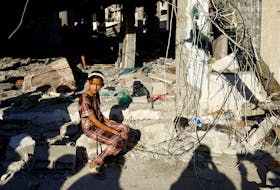It’s a coming of age story.
But not the kind of story anyone wants to unfold.
It’s the story of a young person, who, on the cusp of 18, found themselves without the life supports they relied upon.
In the absence of those supports, they committed suicide.
You can only imagine the despair they grappled with instead of the excitement and anticipation that many teenagers experience on the road to maturity — the whole world at their feet.
The person has not been identified nor their gender given, but the story of their four years in protective care is described in the report issued earlier this month by Child and Youth Advocate Jacqueline Lake Kavanagh.
My sincere condolences to their family, whose pain must be immeasurable.
And yet this is not a case of a child falling through the cracks of an uncaring system.
The report’s title, A Soft Place to Land, is aspirational — it’s what our society thinks every child deserves.
And yet too many children in this province — particularly Indigenous children — do not find a soft place to land when they need it the most.
The young person at the heart of the advocate’s report first came in contact with the child care and protection system at age 14 when they reported having been sexually abused by their father. The government said the man could no longer live in the household, but the police felt there was not enough evidence to lay charges.
“This was a very difficult decision for this young person to hear,” the report notes, “and it created significant distress.”
The child turned against the mother then, feeling she had done too little to protect them, and — after assaulting the mother several times — was taken into protective care.
This pivotal moment — the revelation of the abuse, the feeling of perhaps not being believed — seemed to start a downward spiral for this teenager, who suffered great emotional pain and trauma, often turning to self-harm to express it.
“The youth visited the hospital Emergency Department on several occasions for emergency treatment of self-harm wounds, overdoses, and suicidal ideation,” the report notes. “In the two years prior to death, the youth visited the hospital Emergency Department 26 times, and presented as suicidal on half of those visits.”
And yet this is not a case of a child falling through the cracks of an uncaring system. Indeed, Lake Kavanagh points out that before the age of 18 they were provided with addictions counselling, mental health treatment, alternative schooling options, equine therapy and other services. Many dedicated people tried to help.
The problem was, as the report identifies, there was no seamless transition between child and youth services to adult services once the person turned 18. Despite the efforts of a child and adolescent psychiatrist to smooth the young person’s transition to adult psychiatry, there was no service available.
“The youth’s family doctor contacted the Regional Health Authority’s intake system a few months before the youth’s death to stress the urgent need for services,” the report states.
“Intake indicated the youth would likely be on the waitlist for another year.”
It was another year they did not have. They were still waiting for help when they died by suicide nine months later, despite the strict safety protocols in place at the group home where they lived.
Lake Kavanagh makes several recommendations for improvement in her report, but its main message is twofold. First, that youth need to have an active role in choosing the options available to them. And second, a recognition that a person does not go from child to adult overnight.
When this person took their first hesitant steps outside the protection of the child and youth system, in their very vulnerable condition, there was no floor beneath them; nowhere for them to land.
People in “urgent need” cannot wait a year for help to arrive.
How many children will die before we get it right? Or is the system so strained that we can’t afford to?
Pam Frampton is The Telegram’s managing editor. Email [email protected]. Twitter: pam_frampton








